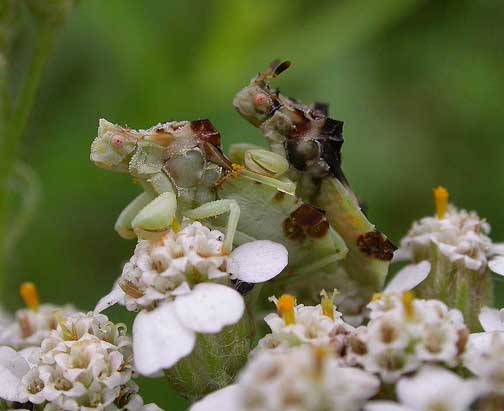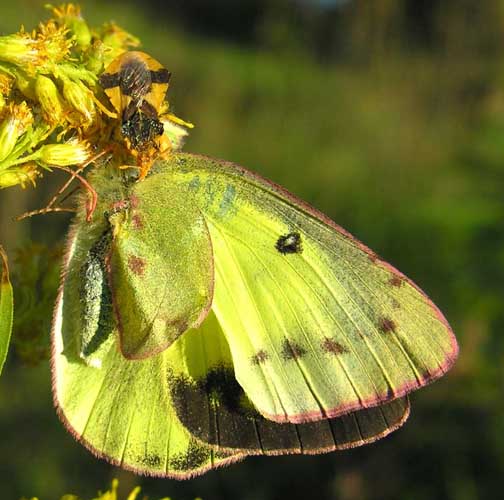July 27th, 2006
more on the phymata
Picking up where I left off a couple of days ago, I’ll write a bit more about Phymata (Ambush bugs).
The two photos in this post are not new — probably a year or two old, as I’m not really seeing much pair activity just yet. At the moment, the individual insects seem to be hunting independently. That will change very soon as males and females pair up and become — quite literally — almost inseparable for the next few weeks.
I don’t know much about how pair selection occurs, but as the summer progresses, most Phymata will find a mate. The male will perch on the female’s back — and as near as I can figure out, they remain there almost constantly. I’ve checked on pairs that are hunting from a particular flower in the garden, and day after day, there they sit, with the male sitting atop the female. As you might be able to see from the top photo, there’s some difference in size between males and females, with the female being a bit larger and more robust.
Of some interest, when there is any hunting activity occurring, it seems to be the female that actually does the work, while the male continues to cling to her back and doesn’t seem to assist. Occasionally, I’ve seen several females working together to pull large bumblebees up onto flowerheads in order to feed. They look like fishermen pulling in a heavy net. Some will be unburdened, but some will have a male stuck to their backs. In late summer and into autumn, the males seem to disappear, and the females continue hunting until the hard frosts come and prey becomes scarce. I suppose they expire soon after.
A couple of years ago, while looking around for information on Phymatidae, I came across something quite interesting. There’s a webpage by Matija Gogala, from the Natural History Museum of Slovenia, that contains some neat info on bioacoustic recordings made of Phymata crassipes. There are recordings of the vibrational songs of Phymata communicating with one another, and also a Phymata “answering” whistles made by a researcher. Just go to this page and scroll to midway down the page and you should see the section about the Phymata. In my opinion, pretty fascinating stuff. I would love to have some kind of bioacoustic recording equipment to capture such sounds as I would not be at all surprised to find that the females that I’ve seen hunting together, are communicating in some way as well.
Last note — the photo below is of a female Phymata that has captured a butterfly. As you can see, these insects can easily capture other insects much larger than themselves. I often find them struggling to haul the largest of Bumblebees up onto a flower top. I know that some of you are probably wondering why I might be fascinated by predatory insects — especially ones that are as lethal as these. The thing is, these predators are part of the food chain, and much as they kill the more pleasing insects such as butterflies, honeybees and bumblebees, they also kill many kinds of wasps and flies that attack and kill bees, or lay eggs that parastize those same insects. So, they are actually helping the bees even while they may also be preying upon them. This summer, I’m going to try to do a bit of survey work here at the farm in an effort to try to figure out the type and number of prey that might be captured by Phymata in a typical oldfield plot. I’ll try to report back with my findings a little later this summer.
Tags: Phymata, Phymatidae


July 27th, 2006 at 10:06 pm
Just folowed you home from somewhere in nj. I have been busy reading and looking.
Great site, and I will be back.
July 27th, 2006 at 10:12 pm
Hi Sandy – Glad you’ve been enjoying my blog. Yes, please do drop back by for another visit!